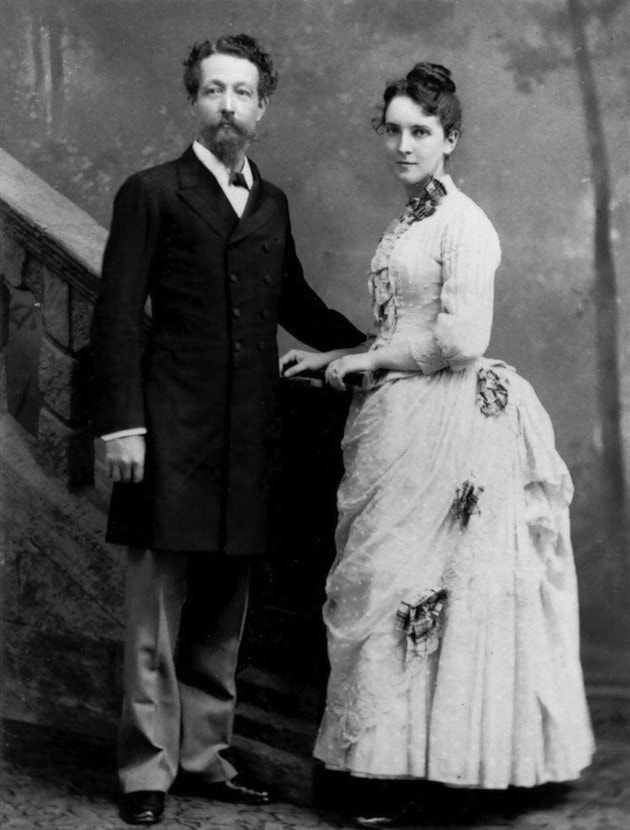This is the story of Bryan Mahon’s grandmother, to be told in five installments. Bryan’s widow, Marolyn, an ardent advocate for the Mahon legacy, passed away in her Mercer Island home on Aug. 15, 11 days after celebrating her 90th birthday.
In 1993, as Judy Watten was visiting her mother in Michigan, one of her daughters discovered a package in a desk in the basement. It had been sent to Judy’s father Waller by his mother Elizabeth in 1933, with directions to burn it after he had read the contents. The packet of 32 letters opened a new window into her grandfather’s budding relationship with Elizabeth d’Abbadie, whom he got to know as Lilli.
She was born on Dec. 9, 1863 in Angoulême, France, to a father she never knew. When he died at age 38 of heart disease in 1865, her mother returned to Hamburg, her place of birth. Although her proper name was Emilie Caroline Elisabeth d’Abbadie, her nickname of Lili stuck. She learned French well enough to teach the language in England at a girl’s school in 1881.
On Nov. 18, 1885 she arrived at Haiphong to assist her older brother Jules who ran a business enterprise on the Red River. She was overwhelmed by the change:
Thirty-eight days, and I was cut adrift from all the prose of the old country — at least that was what I thought when I first put my foot on Tonquin soil, and breathed, with rapturous delight, the mystery-filled air of my new surroundings! … Is there anything like the sunshine in the East? Anything like the sky, the sea, the people?
Her role was to act as hostess to her brother’s business associates. Here his entrepreneurial spirit as a tea and silk merchant rubbed off on her, and she launched her own seed exporting enterprise. On a September day in 1887 she was swept off her feet by a marine engineer who was delivering a new boat to her brother’s shipping dock and mansion on the Red River.
James Knight Rebbeck was born in 1848 into a large, poor household in Wiltshire and raised by his maternal grandparents. At age 15, he was sent to India into the care of an uncle living in Calcutta. Uncle James sent him to school at La Martinère and subsequently to Bengal Engineering College. He was superintendent in the railway workshop of the Howrah Foundry when in 1882 he was offered a position with Victoria Foundry in Hong Kong.
The enterprise manufactured and maintained steamships and undertook other work such as the construction of the Peak Tramway in Hong Kong. The tram was built to provide easy access to the much cooler highlands on Victoria Peak, which had been reserved exclusively for the Europeans. His main responsibility was to design and implement a braking system for the dual cable-linked trams that ran over a steeply-inclined rail.
While working on this project, he visited the French naval base of Haiphong to deliver the steamer “Cerf” to Jules d’Abbadie’s home just up the Red River. There he spotted Elizabeth, who was waiting on the sweeping veranda for the guests. Before he returned to Hong Kong, they were engaged. The painful separation was now bridged by long letters in which details of his daily life are interspersed with his passionate declarations of love.
He writes of the hectic preparations for Queen Victoria’s Golden Jubilee celebrations, ongoing concerns with the brake designs, trying to reduce his dependence on cigarettes, and dealing with the smallpox epidemic that was sweeping the colony. In February 1888, he was testing the brakes:
Tomorrow morning at 10 or 10:30 I shall start from the top, come down in the car to the steep part of the line and try the brakes for gripping power. When we reach the steep part I shall simply drop the automatic mechanism into gear and await the result.
The action was disappointing. They failed to arrest the tram car on the steepest part, but worked satisfactorily on grades less than one-in-six. Changes were implemented, which put a damper on his writing, but he was able to report “complete success” in a Feb. 20 letter.
Elizabeth’s attraction to James was viewed with some alarm by her family and Jules started probing his background. The legality of the forthcoming marriage under the French and English jurisdictions had to be considered also. Other family considerations were the prospective isolation of the couple in an alien world. Love, however, conquers all obstacles and its flame was burning brightly:
It was, it is, it always will be, heart for heart, love for love, and so darling we will live in the sweet bond of affection, friendship and companionship, love all our lives.
To be continued …
Walter Volovsek’s website can be found at trailsintime.org
Previous installments in this series
The Old Glory weather observatory
David Thompson: Mapping our region
Reappraising the Franklin Expedition
Connecting with Albert McCleary
Lilette Mahon: A mentor’s gift
Edward Mahon: Searching for a legacy
Edward Mahon: A stimulating childhood
Intrigues: Castlegar’s lacklustre childhood
Perceptions: Adrift on the River of Life
